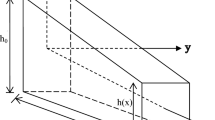Abstract
Purpose
In this paper, a unified and numerically efficient method is proposed to analyse the dynamic response and vibration power flow characteristics of flat isotropic rectangular plate subjected to a harmonic loading.
Method
The boundary of the plate system has been assumed to be elastic boundary and expressed as a combination of translational and rotational spring stiffness, making the system near to real system. The plate displacement function has been derived using combination of trial beam functions, expressed as modified Fourier cosine series, in x and y direction. Finally, Rayleigh-Ritz method is employed to the Lagrangian function to derive the frequency matrix.
Results
The derived frequency matrix can be universally applied to analyse the dynamic response of the plate system and power flow distribution on the plate surface for any condition of boundary condition and force application.
Conclusion
The method is numerically superior to other method because of omission of complex hyperbolic trigonometric functions and appreciable reduction of the size of the frequency matrix, which has been established through comparison of results with the existing literature












Similar content being viewed by others
References
Chen XL, Sheng MP (2007) Research on vibration characteristics of L-shaped plate using a mobility power flow approach. J Mar Sci Appl 6:12–16
Cheung YK, Zhou D (2000) Vibrations of rectangular plates with elastic intermediate line-supports and edge constraints. Thin Walled Struct 37:305–331
Cho DS, Kim BH, Kim JH, Vladimir N, Choi TM (2015) Forced vibration analysis of arbitrarily constrained rectangular plates and stiffened panels using the assumed mode method. Thin Walled Struct 90:182–190
Dozio L (2011) On the use of the Trigonometric Ritz method for general vibration analysis of rectangular Kirchhoff plates. Thin Walled Struct 49(1):129–144
Gorman DJ (2000) Free vibration and buckling of in-plane loaded plates with rotational elastic edge support. J Sound Vib 225:755–773
Jin Guo-yong et al (2010) The influence of edge restraining stiffness on the transverse vibrations of rectangular plate structures. J Mar Sci Appl 9(4):393–402
Kessissoglou NJ (2004) Power transmission in L-shaped plates including flexural and in-plane vibration. J Acoust Soc Am 115:1157–1169
Li WL (2004) Vibration analysis of rectangular plates with general elastic boundary supports. J Sound Vib 273(3):619–635
Li WL, Zhang XF, Du JT, Liu ZG (2009) An exact series solution for the transverse vibration of rectangular plates with general elastic boundary supports. J Sound Vib 321:254–269
Lin TR, Tan ACC, Yan C et al (2011) Vibration of L-shaped plates under a deterministic force or moment excitation: a case of statistical energy analysis application. J Sound Vib 330:4780–4797
Liu CC, Li FM, Liang TW et al (2011) The wave and vibratory power transmission in a finite L-shaped Mindlin plate with two simply supported opposite edges. Acta Mech Sinca 27(5):785–795
Liu X, Banerjee JR (2016) Free vibration analysis for plates with arbitrary boundary conditions using a novel spectral-dynamic stiffness method. Comput Struct 164:108–126
Ma Y, Zhang Y, Kennedy D (2016) Energy flow analysis of mid-frequency vibration of coupled plate structures with a hybrid analytical wave and finite element model. Comput Struct 175:1–14
Pradhan KK, Chakraverty S (2015) Transverse vibration of isotropic thick rectangular plates based on new inverse trigonometric shear deformation theories. Int J of Mech Sci 94–95:211–231
Rao JS (1998) Dynamics of plates. Narosa Publishing House and Marcel Dekker Inc., New Delhi, Madras, Bombay, Calcutta, New York, Basel, Hong Kong
Xianjie Shi, Shi Dongyan (2018) Free and forced vibration analysis of T shaped plates with general elastic boundary supports. J Low Freq Noise Vib Act Control 37(2):355–372
Shu CA (1997) Generalized approach for implementing general boundary conditions in the GDQ free vibration analysis of plates. Int J Mech Sci 34:837–846
Ye T, Jin G, Su Z, Chen Y (2014) A modified Fourier solution for vibration analysis of moderately thick laminated plates with general boundary restraints and internal line supports. Int J Mech Sci 80:29–46
Zhang H, Shi D, Wang Q (2017) An improved Fourier series solution for free vibration analysis of the moderately thick laminated composite rectangular plate with non-uniform boundary conditions. Int J Mech Sci 121:1–20
Zhang X, Li WL (2009) Vibrations of rectangular plates with arbitrary non-uniform elastic edge restraints. J Sound Vib 326(1):221–234
Author information
Authors and Affiliations
Corresponding author
Appendix A
Appendix A
Rights and permissions
About this article
Cite this article
Mahapatra, K., Panigrahi, S.K. Dynamic Response and Vibration Power Flow Analysis of Rectangular Isotropic Plate Using Fourier Series Approximation and Mobility Approach. J. Vib. Eng. Technol. 8, 105–119 (2020). https://doi.org/10.1007/s42417-018-0079-3
Received:
Revised:
Accepted:
Published:
Issue Date:
DOI: https://doi.org/10.1007/s42417-018-0079-3




